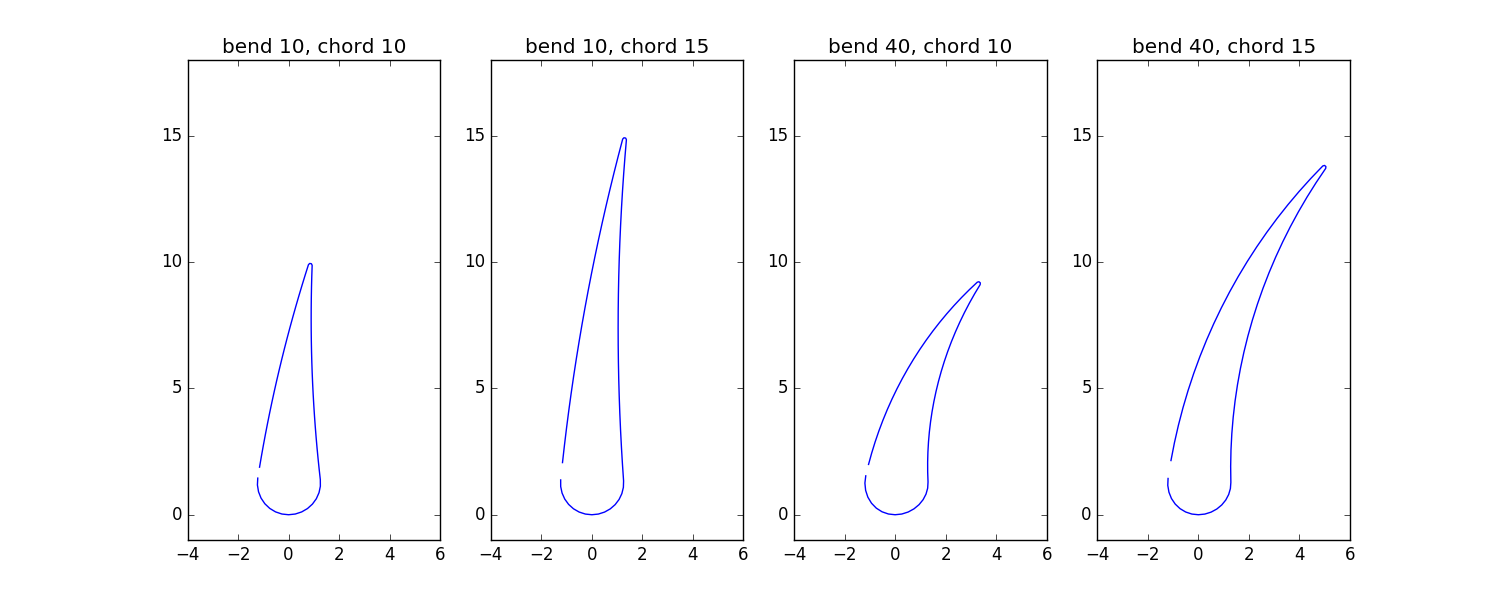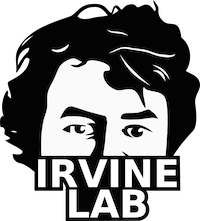Hydrofoil Generation¶
This collection of modules and examples allow users to generate hydrofoils of custom geometry and wing cross-section.
Download and Dependencies¶
The required modules and example scripts are accessible via the git server. To download the code, run the following command (this will require a log-in to the Git server):
$ git clone ssh://<YOUR_NAME>@immenseirvine.uchicago.edu/git/hydrofoils
The cloned folder should contain three modules needed for hydrofoil generation:
- mesh
- frame
- boundary
Along with five example hydrofoil scripts:
- linked rings (linked_rings.py)
- trefoil knot (lia_trefoil.py)
- leap-frogging helix (leapfrog_helix.py)
- ring with modulated bend (mod_bend.py)
- ring with modulated chord (mod_chord.py)
Additionally, there are three auxiliary files containing information needed to run the examples:
- airfoil_attachment_flex_6_32_mini.stl
- airfoil_attachment_flex_6_32_nogive.stl
- raw_path_0p8_2_3.csv
All the files should remain in the same folder.
Important note: ilpm currently has a module called mesh that also handles mesh objects. While very similar, the mesh module contained in ilpm lacks certain functionality necessary for hydrofoil production, so it will be necessary to use the stand-along version contained in the git folder. The hydrofoil code could be instead built around ilpm (by including the path module); however, the desire to have this code be accessible publicly requires that it not include ilpm.
Running the trefoil knot example will test all of the dependencies.
Modules¶
Hydrofoil production depends on three code modules:
- mesh
- frame
- boundary
mesh contains the class Mesh, which is an object for generating a mesh from a point set and then manipulating that mesh with ease. This version of mesh also contains basic path and vector handling functions (frame creation, norms, mags, etc.) which are removed from mesh in the ilpm version and instead included in the vector and path modules.
frame handles the generation of support struts for connecting the hydrofoil to the frame on which it will be accelerated. The two core tasks it accomplishes are (1) creating the struts that connect the feet (which feature holes for 6-32 flat head screws) to the leading edge of the hydrofoil, and (2) creating small but important reinforcing structures at the connection between the strut and the hydrofoil.
boundary handles the formation of capping surfaces, necessary if a path is not closed. While some hydrofoils may be purposefully be generated with a gap, the resulting vortices are in general not stable unless the path is closed.
Example Hydrofoils¶
Linked Rings¶
A pair of linked rings. Useful in showing the production and handling of multiple paths within a single mesh object. Also implements a bend modulation at crossings between distinct paths.
LIA Trefoil Knot¶
The LIA invariant trefoil knot. Useful for showing how you generate a hydrofoil from an imported path and implement a bend modulation at crossings occurring on a single path.
Leap-frogging Helix¶
A leap-frogging helix and planar ring pair. Demonstrates the creation of disjoint but concentric vortices, and shows the flexibility afforded by using user generated paths for the hydrofoil trailing edge.
Ring with Modulated Bend¶
An isolated planar ring with an arbitrary bend profile. Demonstrates how to modulate a particular parameter of the cross-section in an arbitrary way.
Ring with Chord Bend¶
An isolated planar ring with an arbitrary chord profile. Demonstrates how to modulate a particular parameter of the cross-section in an arbitrary way.
Hydrofoil Parameters¶
At the start of nearly every hydrofoil script, there is a bank of parameters that will look like this:
#GENERAL PARAMETERS
scale = 1.5
t_scale = 1.25
aoa = 0
bend = 35
chord = 15 * scale
thickness = 2.5 * t_scale
tip_thickness = 0.15 * t_scale
bend_points = 20
NP = 700
mean_radius = 45. * scale
z_offset = 20
#SPECIFIC PARAMETERS
offset = mean_radius
modulation_width = 0.08
modulation_scale = 0.4
rot_angle = 20*deg
These parameters, which determine both the overall geometry of the hydrofoil as well as the finer details of its cross-section at a point along the path, are grouped into two catagories: general parameters and specific parameters. The specific parameters influence features specific that this particular type of hydrofoil (say, how rotated one ring is relative to the other in a pair of linked rings) and are thus unlikely to appear elsewhere. The general parameters however appear for every hydrofoil and as such as worth understanding:
- scale: This parameter can be used to scale the macro-scopic geometry of the hydrofoil, influencing both the length of the chord and the mean radius of the path (without changing the thickness of the hydrofoil or its bend.)
- t_scale: Similar to scale, but affects only the leading and trailing edge thicknesses.
- aoa: The angle by which the cross-section is rigidly rotated relative to the direction of acceleration. This is typically 0 and has not been tested for many values.
- bend: The angle between the tangent of the centerline at the trailing edge and the vertical measured in degrees. Higher bends will in general produce vortices with higher peak vorticity and stronger circulation. Values explored range from 5 to 45 degrees.
- chord: The distance along the centerline of the hydrofoil cross-section from the leading to trailing edges. Longer chords will in general produce vortices with broader vorticity distributions and stronger circulations. Values explored range from 8 to 22 mm.
- thickness: The thickness of the leading edge in mm. This number is largely static.
- tip_thickness: The thickness of the trailing edge in mm. Empirically, it is beneficial to have this number be as small as possible. This number is also largely static.
- bend_points: The number of points used to sample the circular arcs at both the leading and trailing edges. For typical values of the thickness parameters, a value of 20 is sufficient to avoid any artifacts resulting from the descritization of the path.
- NP: The number of points used to sample the path that defines the path of the trailing edge and thus the geometry of the hydrofoil. This parameter might not be used if that path is imported from an outside source.
- mean_radius: The characteristic size for the hydrofoil. Often this is expressed as the mean radius of some shape, such as a ring, helix, or torus knot. Measured in mm.
- z_offset: The distance between the lowest point on the hydrofoil and the frame, measured in mm. Empirically it does not seem that this number is critical in vortex formation; however, picking too small of an offset may cause flows from the frame to interfere with vortex formation, while picking a number that is very large will needlessly lengthen the struts, making the entire structure weak to torques about the origin.
Hydrofoil Cross-sectional Profile¶
In general, the code used to generate hydrofoils is flexible enough to support cross-sections of any arbitrary shape. Currently, there is a single profile that is used on all hydrofoils known as a ‘rounded taper’, which supports the general parameters, such as chord length and bend angle. This profile is generated by passing a function in mesh called rounded_taper the desired parameters, as shown below:
import matplotlib.pyplot as plt
from mesh import *
aoa = 0
thickness = 2.5
tip_thickness = 0.15
bend_points = 20
bends = [10, 40]
chords = [10, 15]
plt.figure(figsize=(15,6))
for i, bend in enumerate(bends):
for j, chord in enumerate(chords):
outline = rot_z(rounded_taper(chord, thickness/2., tip_thickness/2., bend=bend, aoa=aoa, bend_points=bend_points), pi/2)
x = outline[:, 0:1]
y = outline[:, 1:2]
plt.subplot(1,4,j+1 + 2*i, aspect='equal')
plt.title('bend %d, chord %d'%(bend,chord))
plt.plot(x,y)
plt.xlim(-4, 6)
plt.ylim(-1, 18)
plt.show()
The figure below shows x and y plotted for a variety of cross-section parameters.
The profile is constructed by connecting two circles of diameters set by the two thickness parameters and connecting them by circular arc whose radius of curvature is inversely related to the bend parameter and whose length is the chord. This profile has proved to work for a wide range of experiments; however, if a different profile is desired, simply replace the call to rounded_taper with a function that returns the desired profile (note that each cross-section must be defined by the same number of points, regardless of its shape).
The Hydrofoil is generated by constructing a cross-section at each point along the path and then extruding a tube defined by these cross-sections.
Hydrofoil Codex¶
Keeping track of the parameters used to generate a given hydrofoil is important, since the properties of the hydrofoil might influence how you rescale or interpret various features of the resulting data. Currently, hydrofoil parameters are tracked by assigning each hydrofoil a unique code name (usually two or three letters followed by a %03d padded number). These code names are then the keys into a dictionary, known as the hydrofoil codex, that contains all the parameters for that hydrofoil.
Each of the example files will create an entry in the codex when you generate a hydrofoil. If an entry for that code name already exists in the codex, it will not be overwritten unless that entry is from the same day (indicating that you might be rapidly regenerating the same hydrofoil as you debug or alter it).
The entire process can be captured by the code below:
#construct the name of the codex if one hasn't been hard coded in
HYDROFOIL_CODEX_JSON = None
if not HYDROFOIL_CODEX_JSON:
DATA_ROOT = os.path.expanduser('~/hydrofoils')
if not os.path.exists: os.mkdir(DATA_ROOT)
HYDROFOIL_CODEX_JSON = os.path.join(DATA_ROOT, 'HYDROFOIL_CODEX.json')
#specify the unique code name for the hydrofoil
code = 'KF001'
#define your parameters and values
scale = 1.5
t_scale = 1.25
aoa = 0
bend = 35
chord = 15 * scale
thickness = 2.5 * t_scale
tip_thickness = 0.15 * t_scale
bend_points = 20
NP = 700
mean_radius = 45.*scale
z_offset = 20
modulation_width = 0.06
modulation_scale = 0.60
#log the parameters in a dictionary
hydrofoil_info = {}
hydrofoil_info['scale'] = scale
hydrofoil_info['bend'] = bend
hydrofoil_info['chord'] = chord
hydrofoil_info['thickness'] = thickness
hydrofoil_info['tip_thickness'] = tip_thickness
hydrofoil_info['mean_radius'] = mean_radius
hydrofoil_info['z_offset'] = z_offset
hydrofoil_info['aoa'] = aoa
hydrofoil_info['modulation_width'] = modulation_width
hydrofoil_info['modulation_scale'] = modulation_scale
hydrofoil_info['notes'] = 'notes about this hydrofoil -- we modulate the bend at the upper crossing point'
#check to see if the codex exists, make it if it doesn't
#write the values if there's no conflict
if not os.path.exists(HYDROFOIL_CODEX_JSON):
hydrofoil_codex = {}
hydrofoil_codex[code] = hydrofoil_info
with open(HYDROFOIL_CODEX_JSON, 'w') as f: json.dump(hydrofoil_codex, f, sort_keys=True, indent=1, separators=(',',': '))
else:
hydrofoil_codex = json.load(open(HYDROFOIL_CODEX_JSON,'r'))
#check to see if something was in there from a different day
if code in hydrofoil_codex.keys():
if hydrofoil_codex[code]['creation_date'] != today:
print "PRE-EXISTING ENTRY IN CODEX FOUND FOR GIVEN CODE, NOT MAKING NEW ENTRY"
else:
hydrofoil_codex[code] = hydrofoil_info
with open(HYDROFOIL_CODEX_JSON,'w') as f: json.dump(hydrofoil_codex, f, sort_keys=True, indent=1, separators=(',',': '))
else:
hydrofoil_codex[code] = hydrofoil_info
with open(HYDROFOIL_CODEX_JSON,'w') as f: json.dump(hydrofoil_codex, f, sort_keys=True, indent=1, separators=(',',': '))

